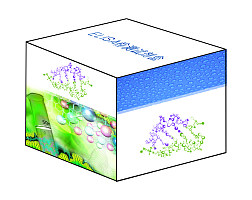
产品详情
文献和实验
相关推荐
样本 : 液体
标记物 :MLC
适应物种 :不限
应用 : 科研单位
检测方法 : 酶联免疫法
检测限 :不限
供应商 : 瓦兰生物
库存 :大量
规格 :96T
大鼠肌球蛋白轻链 ( MLC ) ELISA试剂盒
试剂盒组成
| 名称 | 96孔配置 | 48孔配置 | 备注 |
| 微孔酶标板 | 12孔×8条 | 12孔×4条 | 无 |
| 标准品 | 0.3mL | 0.3mL | 无 |
| 样本稀释液 | 6mL | 3mL | 无 |
| 检测抗体-HRP | 10mL | 5mL | 无 |
| 20×洗涤缓冲液 | 25mL | 15mL | 按说明书进行稀释 |
| 底物A | 6mL | 3mL | 无 |
| 底物B | 6mL | 3mL | 无 |
| 终止液 | 6mL | 3mL | 无 |
| 封板膜 | 2张 | 2张 | 无 |
| 说明书 | 1份 | 1份 | 无 |
| 自封袋 | 1个 | 1个 | 无 |
试剂的准备
20×洗涤缓冲液的稀释:蒸馏水按1:20稀释,即1份的20×洗涤缓冲液加19份的蒸馏水。
洗板方法
- 手工洗板:甩尽孔内液体,每孔加满洗涤液,静置1min后甩尽孔内液体,在吸水纸上拍干,如此洗板5次。
- 自动洗板机:每孔注入洗液350μL,浸泡1min,洗板5次。
- 从室温平衡60min后的铝箔袋中取出所需板条,剩余板条用自封袋密封放回4℃。
- 设置标准品孔和样本孔,标准品孔各加不同浓度的标准品50μL;
- 待测样本孔先加待测样本10μL,再加样本稀释液40μL;
- 随后标准品孔和样本孔中每孔加入辣根过氧化物酶(HRP)标记的检测抗体100μL,用封板膜封住反应孔,37℃水浴锅或恒温箱温育60min。
- 弃去液体,吸水纸上拍干,每孔加满洗涤液,静置1min,甩去洗涤液,吸水纸上拍干,如此重复洗板5次(也可用洗板机洗板)。
- 每孔加入底物A、B各50μL,37℃避光孵育15min。
- 每孔加入终止液50μL,15min内,在450nm波长处测定各孔的OD值。
绘制标准曲线:在Excel工作表中,以标准品浓度作横坐标,对应OD值作纵坐标,绘制出标准品线性回归曲线,按曲线方程计算各样本浓度值。
试剂盒性能
- 准确性:标准品线性回归与预期浓度相关系数R值,大于等于0.9900。
- 灵敏度:最低检测浓度小于0.1 ng/ml。
- 特异性:不与其它可溶性结构类似物交叉反应。
- 重复性:板内变异系数小于10%、板间变异系数小于15%。
- 贮藏:2-8℃,避光防潮保存。
- 有效期:6个月
- 试剂盒仅供研究使用,不得用于临床实验或人体实验,否则所产生的一切后果,由实验者承担,本公司概不负责。
- 严格按照说明书操作,实验者违反说明书操作,后果由实验者承担。
我公司所销售的ELISA试剂盒,品种多,质量好,灵敏度高,涉及的品牌有美国原装/分装等不同价格档次的盒子。
可以代检测(为您节省时间)
具体价格请来电咨询
ELISA检测试剂盒组成:
1:浓缩洗涤液(50ml)20x
2.标本稀释液(12ml)
3.终止液(12ml)
4.标准品(2管)
5.酶标抗体稀释液体(12ml)
6.第一抗体稀释液(12ml)
7.包被酶标板一块
8.坐标纸一张
9.封板纸一张
样品类型(SAMPLE TYPES):
标本必须为液体,不含沉淀。包括血清、血浆、尿液、胸腹水、脑脊液、细胞培养上清、组织匀浆等。1ml的全血可得到0.5ml的血清或血浆。每个标本量收集体积=100ul×检测种类。取材前须向销售人员索要说明书。
标本处理:
收集标本前必须清楚要检测的成份是否足够稳定。对收集后当天进行检测的标本,储存在4℃备用,如有特殊原因需要周期收集标本,将标本及时分装后放在-20℃或-70℃条件下保存。避免反复冻融。标本2-8℃可保存48小时,-20℃可保存1个月。-70度可保存6个月。部分激素类标本需添加抑肽酶。
◇血清:
室温血液自然凝固10-20 分钟后,离心20 分钟左右(2000-3000 转/ 分)。收集上清。如有沉淀形成,应再次离心。
◇血浆:
应根据试剂盒的要求选择EDTA 、柠檬酸钠或肝素作为抗凝剂,加入10 %(v/v )抗凝剂(0.1M 柠檬酸钠或1% heparin 或2.0%EDTA.Na2)混合10-20 分钟后,离心20 分钟左右(2000-3000 转/ 分)。仔细收集上清。如有沉淀形成,应再次离心。
◇尿液、胸腹水、脑脊液:
用无菌管收集。离心20 分钟左右(2000-3000 转/ 分)。仔细收集上清。如有沉淀形成,应再次离心。
◇细胞培养上清:
检测分泌性的成份时,用无菌管收集。离心20 分钟左右(2000-3000 转/ 分)。仔细收集上清。检测细胞内的成份时,用PBS (PH7.2-7.4 )稀释细胞悬液,细胞浓度达到100 万/ml 左右。通过反复冻融,以使细胞破坏并放出细胞内成份。离心20 分钟左右(2000-3000 转/ 分)。仔细收集上清。保存过程中如有沉淀形成,应再次离心。
◇组织标本:
切割标本后,称取重量。加入一定量的PBS ,缓冲液中可加入1 μg/L 蛋白酶抑制剂或50U/ml 的Aprotinin (抑肽酶)。用手工或匀浆器将标本匀浆充分。离心20 分钟左右(2000-3000 转/ 分)。仔细收集上清置于-20 度或- 70 度保存,如有必要,可以将样品浓缩干燥。分装后一份待检测,其余冷冻备用。
检测原理:
采用双抗体夹心ABC-ELISA法
保存温度:2-8℃保存6个月.
注意事项:
收集标本前必须清楚要检测的成份是否足够稳定。对收集后当天进行检测的标本,储存在4 ℃备用,如有特殊原因需要周期收集标本,将标本及时分装后放在-20 ℃或-70 ℃条件下保存。避免反复冻融。标本2 -8 ℃可保存48 小时,-20 ℃可保存1 个月。-70 度可保存6 个月。部分激素类标本需添加抑肽酶。
备注:以上为ELISA试剂盒通用说明书,不包括特别的试剂盒,具体的请参照每个产品的说明书
Sample collection and storages
Serum - Use a serum separator tube and allow samples to clot for 30 minutes before centrifugation for 10 minutes at approximately 3000×g. Remove serum and assay immediately or aliquot and store samples at -20℃ or -80℃.Avoid repeated freeze-thaw cycles
Plasma - Collect plasma using EDTA or heparin as an anticoagulant. Centrifuge samples for 30 minutes at 3000×g at 2-8℃ within 30 minutes of collection. Store samples at -20℃or -80℃. Avoid repeated freeze-thaw cycles.
Cell culture supernates and other biological fluids - Remove particulates by centrifugation and assay immediately or aliquot and store samples at -20℃or -80℃. Avoid repeated freeze-thaw cycles.
Note: The samples should be centrifugated adequately and no hemolysis or granule was allowed.
Materials required but not supplied
1. Standard microplate reader(450nm)
2. Precision pipettes and Disposable pipette tips.
3. 37 ℃ incubator
Precautions
1. Do not substitute reagents from one kit to another. Standard, conjugate and microplates are matched for optimal performance. Use only the reagents supplied by manufacturer.
2. Do not remove microplate from the storage bag until needed. Unused strips should be stored at 2-8°C in their pouch with the desiccant provided.
3. Mix all reagents before using.
Remove all kit reagents from refrigerator and allow them to reach room temperature ( 20-25°C)
Materials supplied
| Name | 96 determinations | 48 determinations |
| Microelisa stripplate | 12*8strips | 12*4strips |
| Standard | 0.3ml | 0.3ml |
| Sample diluent | 6.0ml | 3.0ml |
| HRP-Conjugate reagent | 10.0ml | 5.0ml |
| 20X Wash solution | 25ml | 15ml |
| Chromogen Solution A | 6.0ml | 3.0ml |
| Chromogen Solution B | 6.0ml | 3.0ml |
| Stop Solution | 6.0ml | 3.0ml |
| Closure plate membrane | 2 | 2 |
| User manual | 1 | 1 |
| Sealed bags | 1 | 1 |
80、40、20、10、5、0 nmol/L.
Reagent preparation
20×wash solution:Dilute with Distilled or deionized water 1:20.
Assay procedure
1. Prepare all reagents before starting assay procedure. It is recommended that all Standards and Samples be added in duplicate to the Microelisa Stripplate.
2. Add standard: Set Standard wells, testing sample wells. Add standard 50μl to standard well.
3. Add Sample: Add testing sample 10μl Then add sample diluent 40μl to testing sample well; Blank well doesn’t add anyting.
4. Add 100μl of HRP-conjugate reagent to each well, cover with an adhesive strip and incubate for 60 minutes at 37°C.
5. Aspirate each well and wash, repeating the process four times for a total of five washes. Wash by filling each well with Wash Solution (400μl) using a squirt bottle, manifold dispenser or autowasher. Complete removal of liquid at each step is essential to good performance. After the last wash, remove any remaining Wash Solution by aspirating or decanting. Invert the plate and blot it against clean paper towels.
6. Add chromogen solution A 50μl and chromogen solution B 50μl to each well. Gently mix and incubate for 15 minutes at 37°C. Protect from light.
7. Add 50μl Stop Solution to each well. The color in the wells should change from blue to yellow. If the color in the wells is green or the color change does not
appear uniform, gently tap the plate to ensure thorough mixing.
8. Read the Optical Density (O.D.) at 450 nm using a microtiter plate reader within 15 minutes.
Calculation of results
- This standard curve is used to determine the amount in an unknown sample. The standard curve is generated by plotting the average O.D. (450 nm) obtained for each of the six standard concentrations on the vertical (Y) axis versus the corresponding concentration on the horizontal (X) axis.
- First, calculate the mean O.D. value for each standard and sample. All O.D. values, are subtracted by the mean value of the zero standard before result interpretation. Construct the standard curve using graph paper or statistical software.
- To determine the amount in each sample, first locate the O.D. value on the Y-axis and extend a horizontal line to the standard curve. At the point of intersection, draw a vertical line to the X-axis and read the corresponding concentration.
- Any variation in operator, pipetting and washing technique, incubation time or temperature, and kit age can cause variation in result. Each user should obtain their own standard curve.
- The sensitivity by this assay is 0.1 nmol/L.
- Standard curve
Storage: 2-8℃.
validity: six months.
FOR RESEARCH USE ONLY; NOT FOR THERAPEUTIC OR DIAGNOSTIC APPLICATIONS! PLEASE READ THROUGH ENTIRE PROCEDURE BEFORE BEGINNING!

上海瓦兰生物科技有限公司
实名认证
金牌会员
入驻年限:11年











